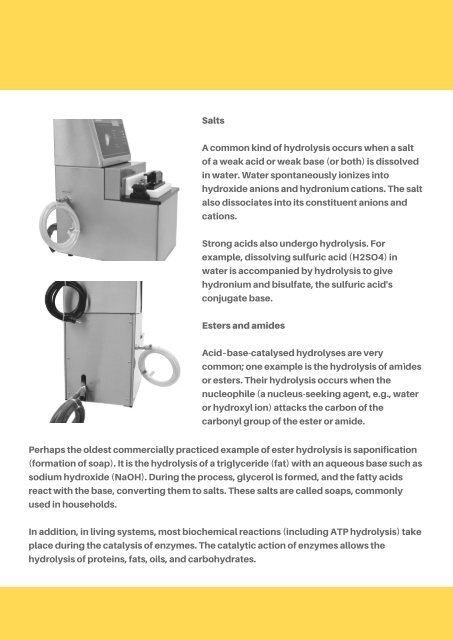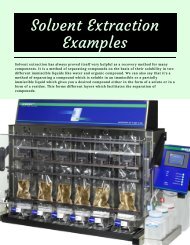Hydrolysis
You also want an ePaper? Increase the reach of your titles
YUMPU automatically turns print PDFs into web optimized ePapers that Google loves.
Salts<br />
A common kind of hydrolysis occurs when a salt<br />
of a weak acid or weak base (or both) is dissolved<br />
in water. Water spontaneously ionizes into<br />
hydroxide anions and hydronium cations. The salt<br />
also dissociates into its constituent anions and<br />
cations.<br />
Strong acids also undergo hydrolysis. For<br />
example, dissolving sulfuric acid (H2SO4) in<br />
water is accompanied by hydrolysis to give<br />
hydronium and bisulfate, the sulfuric acid's<br />
conjugate base.<br />
Esters and amides<br />
Acid–base-catalysed hydrolyses are very<br />
common; one example is the hydrolysis of amides<br />
or esters. Their hydrolysis occurs when the<br />
nucleophile (a nucleus-seeking agent, e.g., water<br />
or hydroxyl ion) attacks the carbon of the<br />
carbonyl group of the ester or amide.<br />
Perhaps the oldest commercially practiced example of ester hydrolysis is saponification<br />
(formation of soap). It is the hydrolysis of a triglyceride (fat) with an aqueous base such as<br />
sodium hydroxide (NaOH). During the process, glycerol is formed, and the fatty acids<br />
react with the base, converting them to salts. These salts are called soaps, commonly<br />
used in households.<br />
In addition, in living systems, most biochemical reactions (including ATP hydrolysis) take<br />
place during the catalysis of enzymes. The catalytic action of enzymes allows the<br />
hydrolysis of proteins, fats, oils, and carbohydrates.






